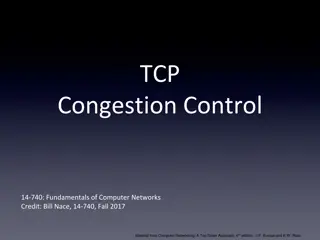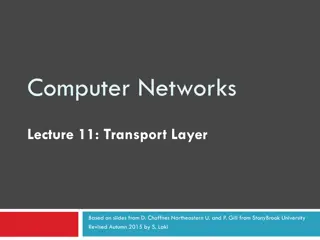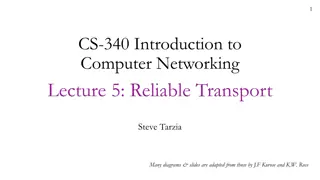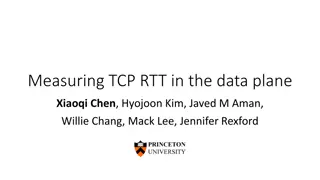Understanding TCP/IP Networking Fundamentals
Explore the basics of TCP/IP networking, including protocols like IP, UDP, RTP, and more. Learn about the structure of the Internet, the role of routers, OSI network model, TCP/IP network model, and packet encapsulation in data transmission. Gain insights into the layers of the OSI model and the TCP/IP hierarchy.
Download Presentation

Please find below an Image/Link to download the presentation.
The content on the website is provided AS IS for your information and personal use only. It may not be sold, licensed, or shared on other websites without obtaining consent from the author. Download presentation by click this link. If you encounter any issues during the download, it is possible that the publisher has removed the file from their server.
E N D
Presentation Transcript
Introduction to TCP/IP networking Mircho Mirchev
TCP/IP protocol family IP : Internet Protocol UDP : User Datagram Protocol RTP, traceroute TCP : Transmission Control Protocol HTTP, FTP, ssh others IP proto numbers 0-255
What is an internet? A set of interconnected networks The Internet is the most famous example Networks can be completely different Ethernet, ATM, modem, (TCP/)IP is what links them
What is an internet? (cont) Routers (nodes) are devices on multiple networks that pass traffic between them Individual networks pass traffic from one router or endpoint to another TCP/IP hides the details as much as possible
ISO/OSI Network Model Seven network layers Layer 1 : Physical cables Layer 2 : Data Link ethernet Layer 3 : Network IP Layer 4 : Transport TCP/UDP Layer 5 : Session Layer 6 : Presentation Layer 7 : Application
TCP/IP Network Model Different view 4 layers Layer 1 : Link (we did not look at details) Layer 2 : Network Layer 3 : Transport Layer 4 : Application
OSI: Open Systems Interconnect OSI and Protocol Stack OSI Model TCP/IP Hierarchy Protocols 7th Application Layer 6th Application Layer Presentation Layer 5th Session Layer 4th Transport Layer Transport Layer 3rd Network Layer Network Layer 2nd Link Layer Link Layer 1st Physical Layer Link Layer : includes device driver and network interface card Network Layer : handles the movement of packets, i.e. Routing Transport Layer : provides a reliable flow of data between two hosts Application Layer : handles the details of the particular application
Packet Encapsulation The data is sent down the protocol stack Each layer adds to the data by prepending headers 22Bytes 20Bytes 20Bytes 4Bytes 64 to 1500 Bytes
TCP/IP A full suite of protocols spanning layers 2 (Datalink) through 7 (Application) Informally named for Transmission Control Protocol (Layer 4 - Transport) and Internet Protocol (Layer 3 - Network), it is comprised of many protocols
MAJOR Layer Associations Datalink Ethernet L2TP (L2 Tunneling protocol) PPP ARP (Address Resolution Protocol) MAC DSL NDP (Neighbor Discovery Protocol) ISDN RARP (Reverse ARP) FDDI IARP (Inverse ARP)
MAJOR Layer Associations Network IP (Internet Protocol) IPv6 (IP Version 6) ICMP/ICMPv6 (Internet Control Message Protocol e.g., ping ) RIPv6 (Routing Information Protocol) OSPF (Open Shortest Path First) Others
MAJOR Layer Associations Transport TCP (Transmission Control Protocol) Reliable, in-sequence delivery of data, connection oriented UDP (User Datagram Protocol) Connectionless, delivery and sequence not guaranteed RUDP (Reliable UDP) BGP (Border Gateway Protocol) SCTP (Stream Control Transmission Protocol) Others
MAJOR Layer Associations Session DNS (Domain Name Service) LDAP (Lightweight Directory Access Protocol) Others Presentation LPP (Lightweight Presentation Protocol)
MAJOR Layer Associations Application FTP (File Transfer Protocol) SNMPvX (Simple Network Management Protocol, versions 1-3) POP3 (Post Office Protocol, version 3) SMTP (Simple Mail Transfer Protocol) Telnet DHCP (Dynamic Host Configuration Protocol) HTTP (HyperText Transfer Protocol) Others (Only underlined protocols will be discussed further.)
Net+OS Provides Transport Session TCP (thru Sockets) UDP (thru Sockets/Fast Sockets & Fast IP ) Application DNS DHCP Telnet Client SNMP Agent HTTP/Advanced Web Servers Email (POP3/SMTP) Clients FTP Client & Server
IP Responsible for end to end transmission Sends data in individual packets Maximum size of packet is determined by the networks Fragmented if too large Unreliable Packets might be lost, corrupted, duplicated, delivered out of order
IP packets Source and destination addresses Protocol number 1 = ICMP, 6 = TCP, 17 = UDP Various options e.g. to control fragmentation Time to live (TTL) Prevent routing loops
IPv4 in Practice Header fields in Network Byte Order Capable (when allowed) of fragmentation and reassembly Packet (datagram) format: 0 16 32 Ver (4) IHL(4) Identification (16) TTL(8) Total Length (bytes) (16) CF(3) Fragment Offset (13) Header Checksum (16) Source IP Address (32) Destination IP Address (32) Options + Padding Data (e.g., TCP Packet) (varies) Service(8) Protocol (8)
IP Header Fields Explained Ver version of IP IHL Internet Header Length (32-bit words) Service Precedence/Delay/Throughput/Reliability Identification assistance in reassembling fragments CF control flags: Reserved 1 to prevent fragmentation, else 0 1 if last fragment, else 0 Fragment Offset of this fragment in total message, bytes TTL Time to Live, upper limit of life enroute Protocol next higher protocol, e.g., TCP, UDP or ICMP
IP addresses 4 bytes e.g. 163.1.125.98 Each device normally gets one (or more) In theory there are about 4 billion available But
Allocation of addresses Controlled centrally by ICANN Fairly strict rules on further delegation to avoid wastage Have to demonstrate actual need for them Organizations that got in early have bigger allocations than they really need
Routing How does a device know where to send a packet? All devices need to know what IP addresses are on directly attached networks If the destination is on a local network, send it directly there
Routing (cont) If the destination address isn t local Most non-router devices just send everything to a single local router Routers need to know which network corresponds to each possible IP address
UDP Thin layer on top of IP Adds packet length + checksum Guard against corrupted packets Also source and destination ports Ports are used to associate a packet with a specific application at each end Still unreliable: Duplication, loss, out-of-orderness possible
UDP in Practice Connectionless protocol Delivery and sequence not guaranteed Rides on IP Header fields in Network Byte Order Packet (datagram) format: 0 16 32 Source Port (16 bits) Length (16 bits) Payload (varies) Destination Port (16 bits) Checksum (16 bits)
UDP datagram 0 16 31 Source Port Destination Port Length Checksum Application data Field Source Port Destination Port Length Checksum Purpose 16-bit port number identifying originating application 16-bit port number identifying destination application Length of UDP datagram (UDP header + data) Checksum of IP pseudo header, UDP header, and data
Typical applications of UDP Where packet loss etc is better handled by the application than the network stack Where the overhead of setting up a connection isn t wanted VOIP NFS Network File System Most games
TCP Reliable, full-duplex, connection- oriented, stream delivery Interface presented to the application doesn t require data in individual packets Data is guaranteed to arrive, and in the correct order without duplications Or the connection will be dropped Imposes significant overheads
TCP in Practice Connection-oriented In-sequence delivery guaranteed Rides on IP Header Fields in Network Byte Order Packet format: 0 16 32 Source Port (16) Sequence Number of First Data Octet (32) Next Expected Ack Number (32) Ofst(4) Rsvd(6) Flags(6) Destination Port (16) Window (16) Urgent Data Pointer (16) Checksum (16) Options + Pad (varies) Payload (varies)
TCP Segment 0 4 10 16 19 24 31 Source Port Destination Port Sequence Number Acknowledgment Number Len Reserved Flags Window Checksum Urgent Pointer Options... Padding Data... Field Source Port Destination Port Sequence Number Acknowledgment # Len Flags Window Checksum Urgent Pointer Options Purpose Identifies originating application Identifies destination application Sequence number of first octet in the segment Sequence number of the next expected octet (if ACK flag set) Length of TCP header in 4 octet units TCP flags: SYN, FIN, RST, PSH, ACK, URG Number of octets from ACK that sender will accept Checksum of IP pseudo-header + TCP header + data Pointer to end of urgent data Special TCP options such as MSS and Window Scale You just need to know port numbers, seq and ack are added
TCP Header Fields Explained Ofst - Data offset/length of header in 32-bit words Rsvd - Reserved Flags Urgent Data Pointer Significant (URG) Ack Field Significant (ACK) Reset Connection (RST) Push Function (PSH) prompt forwarding Synchronize Sequence Numbers (SYN) seq # is initial No More Data (FIN) Window - number of octets sender will accept Option - one octet OR one octet type + one octet length + n octets option information
Applications of TCP Most things! HTTP, FTP, Saves the application a lot of work, so used unless there s a good reason not to
TCP implementation Connections are established using a three-way handshake Data is divided up into packets by the operating system Packets are numbered, and received packets are acknowledged Connections are explicitly closed (or may abnormally terminate)
TCP Packets Source + destination ports Sequence number (used to order packets) Acknowledgement number (used to verify packets are received)
TCP : Data transfer Client Host Send Packet 1 Start Timer Packet Lost Packet should arrive ACK should be sent Timer ACK would normally Arrive at this time Time Expires Retransmit Packet1 Start Timer Receive Packet 1 Send AXK 1 Timer Receive ACK 1 Cancel Timer























